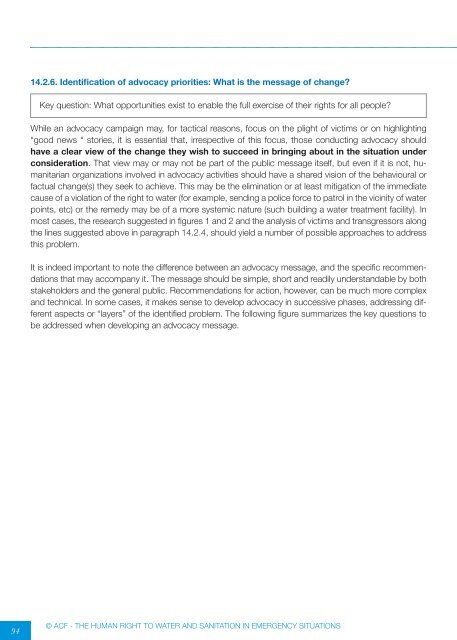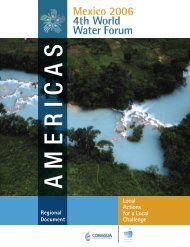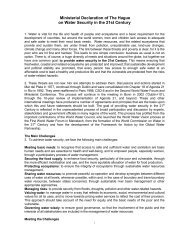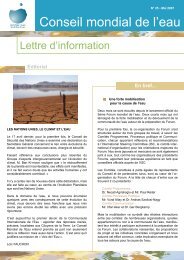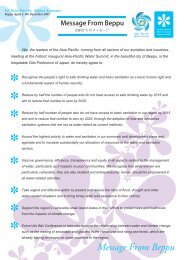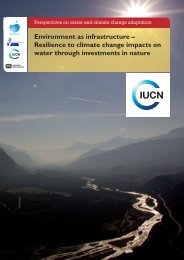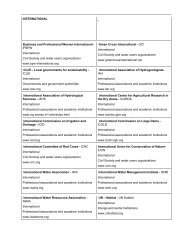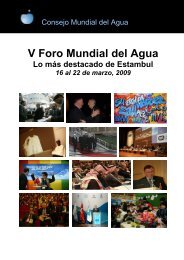the human right to water and sanitation in emergency situations
the human right to water and sanitation in emergency situations
the human right to water and sanitation in emergency situations
You also want an ePaper? Increase the reach of your titles
YUMPU automatically turns print PDFs into web optimized ePapers that Google loves.
94<br />
14.2.6. Identification of advocacy priorities: What is <strong>the</strong> message of change?<br />
Key question: What opportunities exist <strong>to</strong> enable <strong>the</strong> full exercise of <strong>the</strong>ir <strong>right</strong>s for all people?<br />
While an advocacy campaign may, for tactical reasons, focus on <strong>the</strong> plight of victims or on highlight<strong>in</strong>g<br />
“good news “ s<strong>to</strong>ries, it is essential that, irrespective of this focus, those conduct<strong>in</strong>g advocacy should<br />
have a clear view of <strong>the</strong> change <strong>the</strong>y wish <strong>to</strong> succeed <strong>in</strong> br<strong>in</strong>g<strong>in</strong>g about <strong>in</strong> <strong>the</strong> situation under<br />
consideration. That view may or may not be part of <strong>the</strong> public message itself, but even if it is not, <strong>human</strong>itarian<br />
organizations <strong>in</strong>volved <strong>in</strong> advocacy activities should have a shared vision of <strong>the</strong> behavioural or<br />
factual change(s) <strong>the</strong>y seek <strong>to</strong> achieve. This may be <strong>the</strong> elim<strong>in</strong>ation or at least mitigation of <strong>the</strong> immediate<br />
cause of a violation of <strong>the</strong> <strong>right</strong> <strong>to</strong> <strong>water</strong> (for example, send<strong>in</strong>g a police force <strong>to</strong> patrol <strong>in</strong> <strong>the</strong> vic<strong>in</strong>ity of <strong>water</strong><br />
po<strong>in</strong>ts, etc) or <strong>the</strong> remedy may be of a more systemic nature (such build<strong>in</strong>g a <strong>water</strong> treatment facility). In<br />
most cases, <strong>the</strong> research suggested <strong>in</strong> figures 1 <strong>and</strong> 2 <strong>and</strong> <strong>the</strong> analysis of victims <strong>and</strong> transgressors along<br />
<strong>the</strong> l<strong>in</strong>es suggested above <strong>in</strong> paragraph 14.2.4, should yield a number of possible approaches <strong>to</strong> address<br />
this problem.<br />
It is <strong>in</strong>deed important <strong>to</strong> note <strong>the</strong> difference between an advocacy message, <strong>and</strong> <strong>the</strong> specific recommendations<br />
that may accompany it. The message should be simple, short <strong>and</strong> readily underst<strong>and</strong>able by both<br />
stakeholders <strong>and</strong> <strong>the</strong> general public. Recommendations for action, however, can be much more complex<br />
<strong>and</strong> technical. In some cases, it makes sense <strong>to</strong> develop advocacy <strong>in</strong> successive phases, address<strong>in</strong>g different<br />
aspects or “layers” of <strong>the</strong> identified problem. The follow<strong>in</strong>g figure summarizes <strong>the</strong> key questions <strong>to</strong><br />
be addressed when develop<strong>in</strong>g an advocacy message.<br />
© ACF - THE HUMAN RIGHT TO WATER AND SANITATION IN EMERGENCY SITUATIONS


